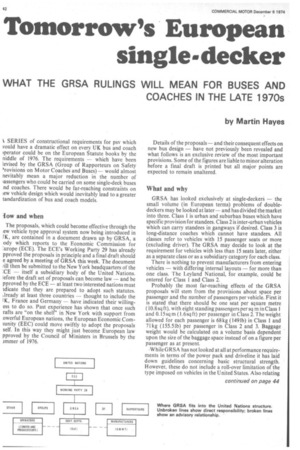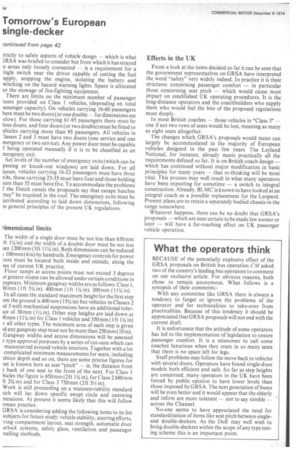Tomorrow's• European single-decker
Page 44

Page 46

If you've noticed an error in this article please click here to report it so we can fix it.
WHAT THE GRSA RULINGS WILL MEAN FOR BUSES AND COACHES IN THE LATE 1970s
by Martin Hayes
k. SERIES of constructional requirements for psv which vould have a dramatic effect on every UK bus and coach perator could be on the European Statute books by the niddle of 1976. The requirements — which have been levised by the GRSA (Group of Rapporteurs on Safety Provisions on Motor Coaches and Buses) — would almost nevitably mean a major reduction in the number of assengers who could be carried on some single-deck buses nd coaches. There would be far-reaching constraints on Lew vehicle design which would inevitably lead to a greater tandardization of bus and coach models.
low and when
The proposals, which could become effective through the ew vehicle type approval system now being introduced in IK, are contained in a document drawn up by GRSA, a ody which reports to the Economic Commission for ;urope (ECE). The ECE's Working Party 29 has already pproved the proposals in principle and a final draft should e agreed by a meeting of GRSA this week. The document till then be submitted to the New York headquarters of the CE -itself a subsidiary body of the United Nations. efore the draft set of proposals can become law — and be pproved by the ECE — at least twointerested nations must Idicate that they are prepared to adopt such statutes. Arcady at least three countries — thought to include the X, France and Germany — have indicated their willingess to do so. Past experience has shown that once such rafts are "on the shelf' in New York with support from owerful European nations, the European Economic Coln'unity (EEC) could move swiftly to adopt the proposals self. In this way they might just become European law pproved by the Council of Ministers in Brussels by the miner of 1976. Details of the proposals — and their consequent effects on new bus design — have not previously been revealed and what follows is an exclusive review of the most important provisions. Some of the figures are liable to minor alteration before a final draft is printed but all major points are expected to remain unaltered.
What and why
GRSA has looked exclusively at single-deckers. — the small volume (in European terms) problems of doubledeckers may be looked at later— and has divided the market into three. Class I is urban and suburban buses which have specific provision for standees. Class 2 is inter-urban vehicles which can carry standees in gangways if desired. Class 3 is long-distance coaches which cannot have standees. All classes refer to vehicles with 15 passenger seats or more (excluding driver). The GRSA may decide to look at the requirement for vehicles with less than 15 seats later, either as a separate class or as a subsidiary category for each class. There is nothing to prevent manufacturers from entering vehicles — with differing internal layouts — for more than one class. The Leyland National, for example, could be entered for Class 1 and Class 2.
Probably the most far-reaching effects of the GRSA proposals will stem from the provisions about space per passenger and the number of passengers per vehicle. First it is stated that there should be one seat per square metre (10.8 sq ft), with eight standing passengers per sq m in Class 1 and 0.15 sq m (1.6 sq ft) per passenger in Class 2. The weight allowed for each passenger is 68 kg ( 1491b) in Class 1 and 71 kg (155.51b) per passenger in Class 2 and 3. Baggage weight would be calculated on a volume basis dependent upon the size of the baggage space instead of on a figure per passenger as at present.
-While GRSA has not looked at all at performance requirements in terms of the power pack and driveline it has laid down guidelines concerning basic structural strength. However, these do not include a roll-over limitation of the type imposed on vehicles in the United States. Also relating trictly to safety aspects of vehicle design — which is what )RSA was briefed to consider but from which it has strayed o areas only loosely connected — is a requirement for a ingle switch near the driver capable of cutting the fuel upply, stopping the engine, isolating the battery and witching on the hazard warning lights. Space is allocated or the stowage of fire-fighting equipment.
There are limits on the minimum number of passenger loon provided on Class 1 vehicles, (depending on total ■ assenger capacity). On vehicles carrying 16-60 passengers here must be two doors (or one double — for dimensions see ,elow). For those carrying 61-95 passengers there must be hree doors, and four doors (or two double) must be fitted to ehicles carrying more than 95 passengers. All vehicles in 7lasses 2 and 3 must have two doors (one service and one mergency or two service). Any power door must be capable f being operated manually if it is to be classified as an mergency exit.
Set levels of the number of emergency exits (which can be pening or knock-out windows) are laid down. For all lasses, vehicles carrying 16-22 passengers must have three Kits, those carrying 23-35 must have four and those holding lore than 35 must have five. To accommodate the problems f the Dutch canals the proposals say that escape hatches may" be required in the roof. The emergency exits must be istributed according to laid down dimensions, following ie general principles of the present UK regulations.
limensional limits
The width of a single door must be not less than 650 mm .ft 13/4 in) and the width of a double door must be not less Ian 1200 mm (3 ft 111/4 in). Both dimensions can be reduced '7100 mm (4 in) by handrails. Emergency controls for power )ors must be located both inside and outside, along the les of current UK practice.
Floor ramps at access points must not exceed 3 degrees It greater slopes can be allowed under certain conditions in tngways. Minimum gangway widths are as follows: Class 1, i0 mm (1 ft 53/4 in). 400 mm (1 ft 13/4 in). 300 mm (113A in). In all cases the standard maximum height for the first step om the ground is 400 mm (15% in) but vehicles in Classes 2 id 3 with mechanical suspensions have an additional tolerice of 30mm (11/4 in). Other step heights are laid down at mm (11% in) for Class 1 vehicles and 350mm (1 ft 1% in) r all other types. The minimum area of each step is given id any gangway step must not be more than 250 mm(10 in). Gangway widths and access dimensions will be assessed r type approval purposes by a series of cut-outs which can manoeuvred around vehicle interiors. Together with a lot complicated minimum measurements for seats, including shion depth and so on, there are some precise figures for tat is known here as seat "pitch" ie, the distance from back of one seat to the front of the next. For Class 1 hides the figure is 650mm (2ft 13/4 in), for Class 2 680 mm ft 23/4 in) and for Class 3 750 mm (2ft 51,4 in).
Work is still proceeding on a manoeuvrability standard lich will lay down specific swept circle and outswing nensions. At present it seems likely that this will follow Irman practice.
GRSA is considering adding the following items to its list subjects for future study: vehicle stability, steering efforts, ving compartment layout, seat strength, automatic door erlock systems, safety glass, ventilation and passenger nailing methods.
Effects in the UK
From a look at the items decided so far it can be seen that the government representatives on GRSA have interpreted the word "safety" very widely indeed. In practice it is their strictures concerning passenger comfort — in particular those concerning seat pitch — which would cause most impact on established UK operating procedures. It is the long-distance operators and the coachbuilders who supply them who would feel the bite of the proposed regulations most deeply.
In most British coaches — those vehicles in "Class 3" — one if not two rows of seats would be lost, meaning as many as eight seats altogether.
The changes which GRSA's proposals would mean can largely be accommodated •in the majority of European vehicles designed in the past few years. The Leyland National, for instance, already meets practically all the requirements defined so far. It is on British coach design — which has continued without major modification in basic principles for many years — that re-thinking will be most vital. This process may well result in what many operators have been expecting for sometime — a switch to integral construction. Already, BL MC is known to have looked at an integral coach as a possible replacement for the Leopard. Present plans are to retain a separately bodied chassis in the range somewhere.
Whatever happens, there can be no doubt that GRSA's proposals — which are near certain to be made law sooner or later — will have a far-reaching effect on UK passenger vehicle operation.












































































































































